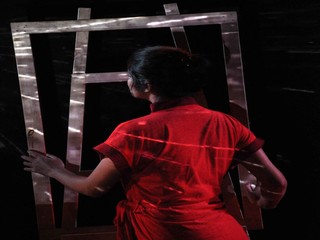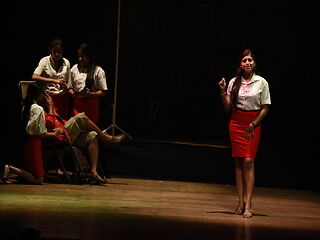Our Production
Canvas
Design & Direction Debasish Dutta
The play 'Canvas' is actually the play of an artist's search for himself How an artist's own sense of life affects his creation, and the world around us, people, society, and everything creates a relationship between the artist and the art he creates. 'Canvas' tells the story of an artist who overcomes the pains of his personal life and overcomes his failures and disappointments to win art.
kaanXtion
Play Debasish Dutta
Direction Kartick Bera
Light Prosenjit Bhattacharyajee
The ear is the hearing aid of the human body. However, in the real social context, when this ear becomes the 'only indicator of quality', there is an oscillation of ear-saving and cutting. The symbolism of this oscillation is the main theme of the production.
When the upper class in the society joins the ear-cutting group, then the lower class shows that the ear is intact. This overall contradiction between the real ear and the fake ear suggests that in order to get status in the society, one has to cut off the ear in one way or another; That is, in simple language what is called 'compromise'.
An ordinary boy faces a variety of people to get the man he loves, just for one ear. Because, the only condition of the girl's father is a celebrity ear, which is real. As soon as he gets this ear, one hundred celebrity ears will be added to his collection. Only on this condition will he accept the Sobuj, that is, the boy as worthy of his daughter.
The quest to find this ear continues the story of the production. And in this tour, Sabuj is accompanied by a broker, Bibi.
In the story, in order to find Sabuj and Bibi ears, sometimes the social worker sometimes goes to the famous heroine. On their way, they encounter the infamous Mafia Dawn and the famous Minister . Eventually they go to Baba Kamadeva's ashram. This tour of the story, in the end, Sobuj changed radically . Its a metaphorical Comic production 'kaanXtion' by Institute of factual theatre arts.
Bhanga Samporker Jadughar (The Museum of Broken Relationships)
Play - Debasish Dutta
Design & Direction - Debasish Dutta
A museum of broken relationships, was created in 2010 in Croatia. The four-year relationship between filmmaker Olinka Vistika and sculptor Drazen Grubisic broke up in 2003. In the midst of the pain of separation, they joked about what it would be like to have a collection of things related to their relationship! In the beginning, it was just a matter of words, but after three years, both of them became really moved.
They start asking friends about something with which they have memories of their relationship. A number of things came together, and they are on display at one of Zagreb's art galleries. This collection then went on a world tour. Went to Germany, Bosnia, Argentina, South Africa, Singapore, Turkey, America, many more countries. Gathering resources began to increase with the donations of sympathetic people. Thirty new things were found in one Berlin, all with the pain of separation.
Olinka and Drazen also made several requests to the Croatian Ministry of Culture for a permanent address in the collection. Every time they saw the application failing, they lost their cash. They rented a 3,200-square-foot space in Zagreb. Croatia's first privately owned museum was built there in October 2010.
What's in this museum? A pair of stiletto shoes for girls, a one-page gastritis tablet, a broken watch, a coffeemaker, a sketch of a couple painted on the subway, a bottle opener, homemade groom-doll dolls, mother and baby frog dolls, torn gloves, and more. Needless to say, there is a story attached to each thing. The story of a broken relationship.
In 2016, a branch was formed in Los Angeles. Ifta's new play 'Museum of Broken Relationships' is a collage of a few stories, as well as stories of broken relationships that are paired with everything carefully preserved in this museum.
Outside of the conventional theater's familiar storytelling, the play is a new kind of experience where the character, not the character, becomes the focal point of the play. Based on a one-story teller, the director combines one story with another. During the play, pictures are drawn little by little on a huge canvas placed on the stage. What comes to fruition at the end of the play, just like the mix of different stories from Japan, Germany, Slovenia, Croatia, takes the play to a world of deep feeling in the end.












